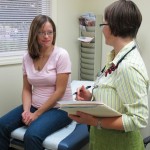As Idaho’s Doctor Workforce Ages, Who Is Stepping Up To Replace Them?
Many states don’t have enough doctors. As we’ve been reporting, Idaho has fewer physicians per capita than every state in the nation except Mississippi.
And the shortage of doctors will likely get worse before it gets better, as physicians from the baby boom generation get ready to retire. At least one-third of all doctors in each of the 50 states are 55 or older. In Idaho, nearly 42 percent of physicians are over the age of 55.

Emilie Ritter Saunders / StateImpact Idaho
Click on the image to enlarge. Data source: American Medical Association's 2012 publication 'Physician Characteristics and Distribution in the U.S.'
University of Washington researcher Susan Skillman says the aging workforce means retirement will soon take its toll. “We have great concern about whether the number of providers we have now can be replaced,” Skillman says, “let alone meet this growing demand” for health care services.
It isn’t just that older doctors will be retiring. There’s also a generational shift in mentality going on. Younger doctors and students working their way through medical school are more interested in a work-life balance than their retirement-age colleagues.
“We’re unlikely to get the kinds of personalities of a rural physician we’ve had in the past where they accept a 24/7 job,” Skillman explains. “It’s going to be very hard to replace a lot of these people.”
Skillman expects communities or clinics won’t be able to replace one 60-something doctor with one 30-something doctor.
Dr. Jennifer Petrie’s story is one example. She’s a family physician in Emmett, Idaho, a town of about 6,000 people less than an hour outside of Boise. She accepted the job nearly two years ago. Establishing a work schedule that allows her to spend time with her three kids and husband was part of the deal. She works four half-days in a clinic, and works an all-night emergency room shift a couple times a month.

Emilie Ritter Saunders / StateImpact Idaho
Photos of Dr. Petrie's kids proudly line her cluttered desk. Their latest drawings hang next to her medical school diploma.
“I’m not in this building seeing patients full-time,” Petrie says. “That gives me a little more time to do my mom stuff. That’s important to me.”
Petrie admits it’s taken her a while to get to this point. Before she had kids, she’d easily spend 12 or 14 hours at work each day. “And that’s if I didn’t have someone in labor,” she says. “I thought nothing of it. But when I had those twins…it became very apparent to me it wasn’t going to be feasible anymore.”
Like researcher Susan Skillman, Petrie worries about her aging colleagues and what retirements will mean for towns across Idaho.
“I personally know docs who, 20 years ago if they were this age, they’d be out of medicine already,” Petrie says. “They’re hanging in there because they know there aren’t people coming in to fill the gaps.”



